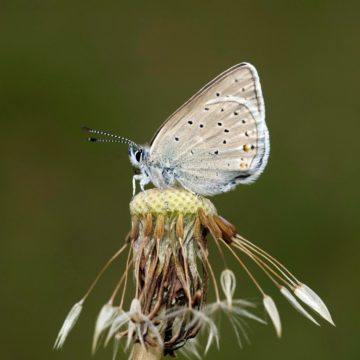Carl Zimmer in The New York Times (2011):
 Vladimir Nabokov may be known to most people as the author of classic novels like “Lolita” and “Pale Fire.” But even as he was writing those books, Nabokov had a parallel existence as a self-taught expert on butterflies. He was the curator of lepidoptera at the Museum of Comparative Zoology at Harvard University, and he collected the insects across the United States. He published detailed descriptions of hundreds of species. And in a speculative moment in 1945, he came up with a sweeping hypothesis for the evolution of the butterflies he studied, a group known as the Polyommatus blues. He envisioned them coming to the New World from Asia over millions of years in a series of waves.
Vladimir Nabokov may be known to most people as the author of classic novels like “Lolita” and “Pale Fire.” But even as he was writing those books, Nabokov had a parallel existence as a self-taught expert on butterflies. He was the curator of lepidoptera at the Museum of Comparative Zoology at Harvard University, and he collected the insects across the United States. He published detailed descriptions of hundreds of species. And in a speculative moment in 1945, he came up with a sweeping hypothesis for the evolution of the butterflies he studied, a group known as the Polyommatus blues. He envisioned them coming to the New World from Asia over millions of years in a series of waves.
Few professional lepidopterists took these ideas seriously during Nabokov’s lifetime. But in the years since his death in 1977, his scientific reputation has grown. And over the past 10 years, a team of scientists has been applying gene-sequencing technology to his hypothesis about how Polyommatus blues evolved. Last week in The Proceedings of the Royal Society of London, they reported that Nabokov was absolutely right.
“It’s really quite a marvel,” said Naomi Pierce of Harvard, a co-author of the paper.
Nabokov inherited his passion for butterflies from his parents. When his father was imprisoned by the Russian authorities for his political activities, the 8-year-old Vladimir brought a butterfly to his cell as a gift. As a teenager, Nabokov went on butterfly-hunting expeditions and carefully described the specimens he caught, imitating the scientific journals he read in his spare time. Had it not been for the Russian Revolution, which forced his family into exile in 1919, Nabokov said that he might have become a full-time lepidopterist.
In his European exile, Nabokov visited butterfly collections in museums. He used the proceeds of his second novel, “King, Queen, Knave,” to finance an expedition to the Pyrenees, where he and his wife, Vera, netted more than a hundred species. The rise of the Nazis drove Nabokov into exile once more in 1940, this time to the United States. It was there that Nabokov found his greatest fame as a novelist. It was also there that he delved deepest into the science of butterflies.
Nabokov spent much of the 1940s dissecting a confusing group of species called Polyommatus blues. He developed forward-thinking ways to classifying the butterflies, based on differences in their genitalia. He argued that what were thought to be closely related species were actually only distantly related.
More here.
